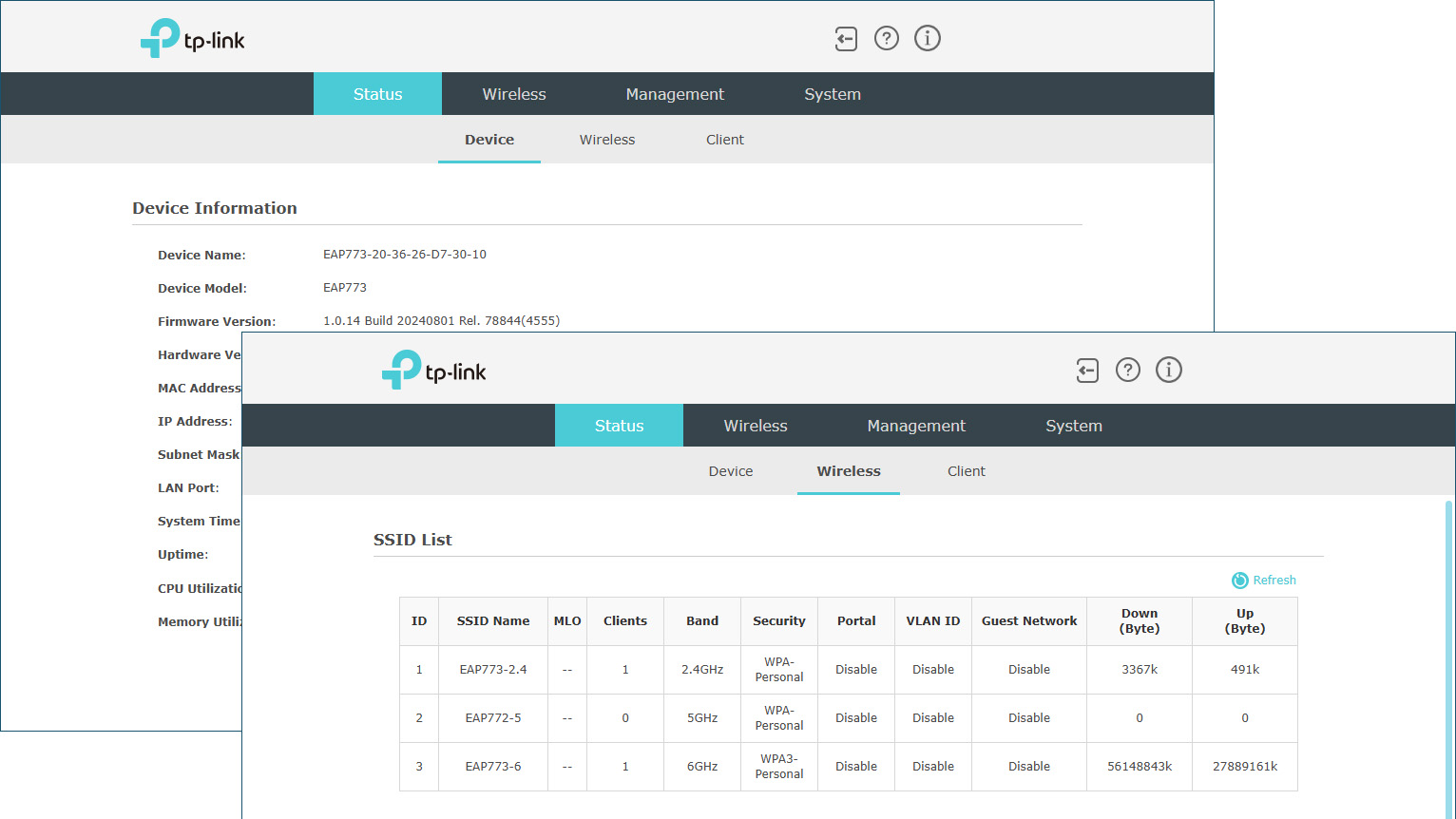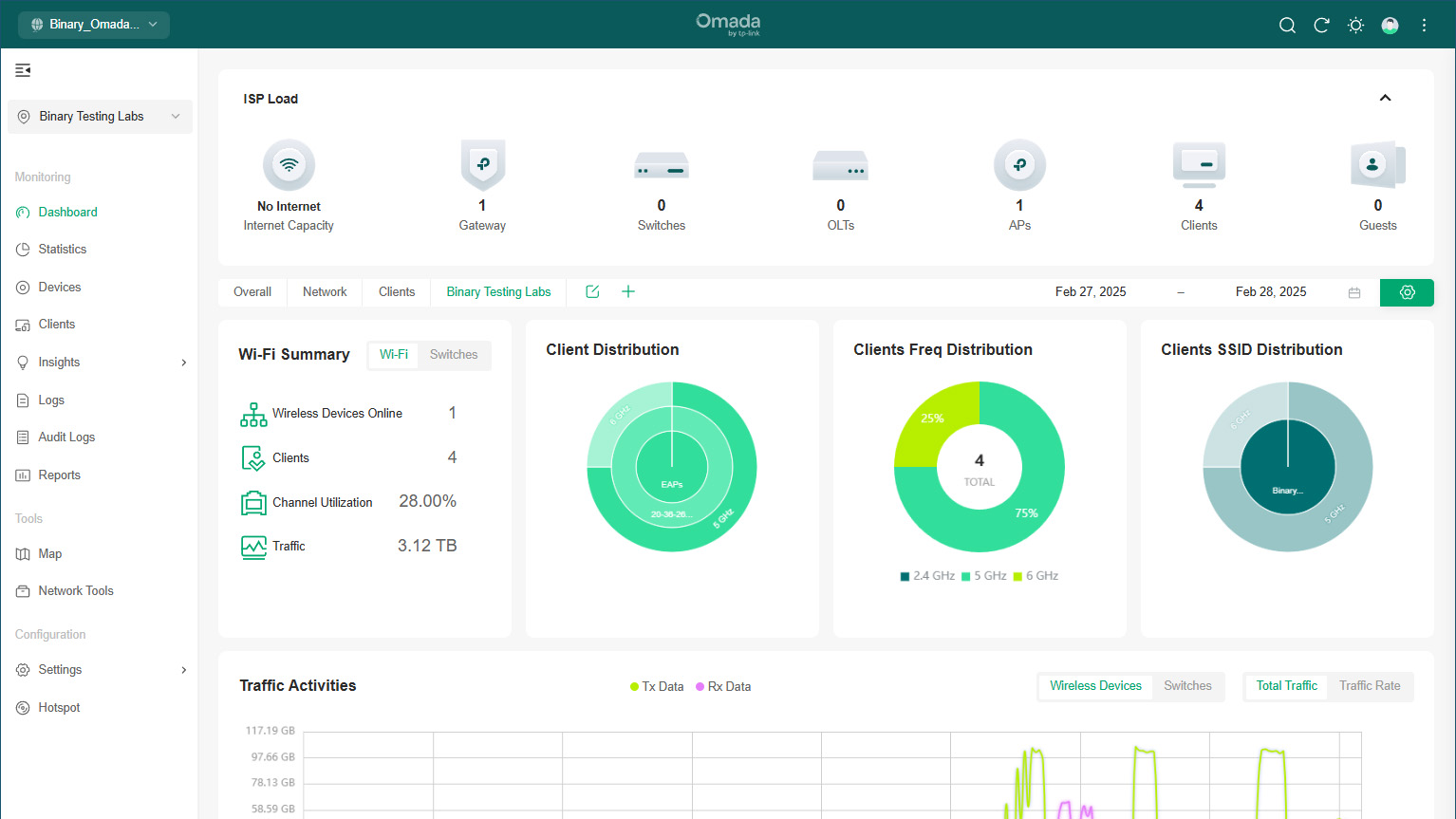TP-Link Omada EAP773 review: A 10GbE-equipped Wi-Fi 7 AP with a speed boost
The 10GbE port bumps the price up, but this business BE9300 Wi-Fi 7 AP repays you with superior performance and slick cloud management

-
+
Easy deployment
-
+
10GbE port
-
+
Good Wi-Fi 7 performance
-
+
Standalone or cloud management
-
-
Not the best value
-
-
Requires a PoE++ power source

TP-Link has always been at the forefront of wireless network development and its mighty BE19000-rated EAP783 Wi-Fi 7 access point (AP) set a very high standard for performance. A price tag of over £600 won't endear it to SMBs though, making the EAP773 on review a much more affordable alternative.
The EAP773 has a lower BE9300 rating and claims to deliver up to 573Mbits/sec on its 2.4GHz radio, 2,880Mbits/sec on 5GHz, and 5,760Mbits/sec on 6GHz with the ultra-wide Wi-Fi 7 320MHz channels enabled. The US version of this AP has a higher BE11000 rating as it supports the 5GHz 240MHz channels to increase maximum speed on this radio to 4,320Mbits/sec.
Costing just under £200 excluding VAT, the EAP773 initially looks expensive for a BE9300 AP, but it is endowed with a 10GbE multi-Gig network port. The majority of budget-priced Wi-Fi 7 APs cost around £60 less but only offer a 2.5GbE port.
Management options abound as the EAP773 can be deployed in standalone mode and configured from its own web console. TP-Link's Omada cloud service will appeal to businesses with multiple APs and sites as they can keep a close eye on them all, along with Omada-enabled switches and routers, from one central web portal.
TP-Link Omada EAP773 review: Standalone mode
In standalone mode, the AP's web console wizard requests a new username and password and tightens security by deleting the default admin account. Eight SSIDs per radio are supported, and the wizard offers you the option of configuring one for each radio and providing encryption keys.
The device status page provides plenty of information about the AP, including bar charts of CPU and memory utilization. Move to the wireless page, and you can see all SSIDs along with details on their associated radios, security, and guest networks, with another view showing all connected clients.
Creating new SSIDs is as swift as you select a radio, providing a name, enabling SSID masking if required, and choosing an encryption scheme up to the mandatory Wi-Fi 7 WPA3. The EAP773 supports MLO (multi-link operations) but only applies it to the 5GHz and 6GHz radios.
Basic captive portals can be applied to selected SSIDs, although authentication is limited to a global password or an external Radius server. When guests connect, you can apply a redirect URL and present them with a web page and AUP (acceptable use policy) message that they must accept to continue.
TP-Link has updated its Omada mobile app, which now supports managing APs in standalone mode. Connect your device to one of its SSIDs, choose this mode, and you can view the AP's status, enable and disable selected radios, and create new SSIDs.

TP-Link Omada EAP773 review: PoE confusion and Wi-Fi 7 performance
We hooked the EAP773 up to the lab's Zyxel XS1930-12HP switch, which provides twelve 10GbE ports with up to 802.3bt PoE++ power delivered on the first eight. The switch status LEDs reported the AP connecting at 10GbE and drawing 802.3bt PoE++ power.
The AP's datasheet states that early firmware versions required a PoE++ source, with the latest version we were running supposed to drop this to PoE+. There's more confusion as the product page on TP-Link's UK website says PoE++, whereas the US site shows PoE+.
For Wi-Fi 7 performance testing, we used a Lenovo desktop client running Windows 11 Pro 24H2 and equipped with a TP-Link Archer TBE550E Wi-Fi 7 PCIe adapter. To gauge raw performance, we used Microsoft's NTttcp utility, which reported upstream and downstream speeds of 310MB/sec and 235MB/sec between the client and a server on the 10GbE LAN
Real-world performance was noticeably lower with large file copies between the client and server, averaging top close range speeds of 245MB/sec, while moving the AP 10 metres away and into an adjoining room saw average speeds of 205MB/sec. The 10GbE port has a measurable impact on performance as TP-Link's 2.5GbE-equipped BE9300 EAP772 delivered NTttcp upstream and downstream speeds of 219MB/sec and 201MB/sec and top close-range file copy speeds of 192MB/sec.
TP-Link Omada EAP773 review: Cloud management
For remote management, you can choose from TP-Link's hardware and free software on-site controllers or use its cloud-based versions. The latter has extra appeal as TP-Link now offers a free Omada Essentials cloud controller, which provides a base set of management and monitoring features for small businesses.
The main Omada portal presents a list of all controllers assigned to your account. We use TP-Link's Standard cloud controller, and selecting it took us to its own portal, which presented a customisable dashboard and a ribbon across the top showing internet capacity, gateway usage, switches, APs, clients, and guests.
To manage the EAP773, we used the Omada iOS app to scan its barcode, add it to our site, and assign a cloud license to it. Once adopted, it took all its settings from the controller and broadcast our predefined SSIDs.
The cloud portal supports the same number of SSIDs as standalone mode, and from the site settings page, you can easily create new ones and apply encryption schemes and rate limits. Our TP-Link Wi-Fi 7 adapter supports MLO using MLMR (multi-link multi-radio), but after enabling it on the site SSID, our Windows 11 client wouldn't create an aggregated link. The reason is that the adapter supports MLMR using either the 2.4/5GHz or 2.4/6GHz bands, so it won't work with the AP, which only applies MLO to the 5/6GHz bands.
Cloud management enables many other features, such as wireless meshing to increase coverage using compliant APs. Captive portal features are also superior as cloud profiles support a wider range of authentication methods and offer options to present custom portal pages with your own choice of colors, logos, and messages.

TP-Link Omada EAP773 review: Is it worth it?
The 10GbE port pushes the price up, but our lab tests show it could be worth the extra spend as maximum performance is noticeably better than lower-cost Wi-Fi 7 APs with 2.5GbE ports. TP-Link needs to sort out its confusion about the required power source, and we would suggest specifying PoE++, although switches that deliver this are also more expensive.
The EAP773 will appeal to businesses that want some extra network bandwidth that entry-level Wi-Fi 7 APs can't deliver. Overall performance is good, it's easy to deploy, and TP-Link's Omada cloud platform offers great remote management services.
TP-Link Omada EAP773 specifications
Type | BE9300 tri-band 2.4/5/6GHz 802.11be | Row 0 - Cell 2 |
Aerials | Internal – 2 x 2.4GHz, 2 x 5GHz, 2 x 6GHz | Row 1 - Cell 2 |
Network | 10GbE multi-Gig (LAN/802.3bt PoE++) | Row 2 - Cell 2 |
SSIDs | Max 24 - 8 on each radio | Row 3 - Cell 2 |
Mounting | Ceiling/wall | Row 4 - Cell 2 |
Brackets included | Yes | Row 5 - Cell 2 |
Power | Optional external PSU | Row 6 - Cell 2 |
Dimensions (WDH) | 220 x 32.5 x 220mm | Row 7 - Cell 2 |
Weight | 736gms | Row 8 - Cell 2 |
Management | Standalone, Omada controller cloud/software/hardware | Row 9 - Cell 2 |
Warranty | Limited lifetime | Row 10 - Cell 2 |
Get the ITPro daily newsletter
Sign up today and you will receive a free copy of our Future Focus 2025 report - the leading guidance on AI, cybersecurity and other IT challenges as per 700+ senior executives
Dave is an IT consultant and freelance journalist specialising in hands-on reviews of computer networking products covering all market sectors from small businesses to enterprises. Founder of Binary Testing Ltd – the UK’s premier independent network testing laboratory - Dave has over 45 years of experience in the IT industry.
Dave has produced many thousands of in-depth business networking product reviews from his lab which have been reproduced globally. Writing for ITPro and its sister title, PC Pro, he covers all areas of business IT infrastructure, including servers, storage, network security, data protection, cloud, infrastructure and services.
-
 Layoffs loom for underskilled tech workers and poor performers – but there's light on the horizon for those willing to upskill
Layoffs loom for underskilled tech workers and poor performers – but there's light on the horizon for those willing to upskillNews Tech hiring managers expect to make layoffs in the coming months, with roles ripe for automation and workers with outdated skills the most likely to be cut.
By Emma Woollacott Published
-
 Executives think AI can supercharge cybersecurity teams – analysts aren’t convinced
Executives think AI can supercharge cybersecurity teams – analysts aren’t convincedNews As organizations adopt AI, frontline cybersecurity workers are worried AI will reduce job security and increase their manual workload
By Rory Bathgate Published
-
 Software deployments are plagued by delays: Rampant skills shortages and underinvestment are slowing down processes – and it’s costing businesses big
Software deployments are plagued by delays: Rampant skills shortages and underinvestment are slowing down processes – and it’s costing businesses bigNews UK software deployments are running an average of four months beyond schedule, new research shows, with delays affecting more than eight-in-ten businesses.
By Emma Woollacott Published